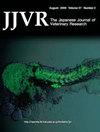利用白刺蝇作为潜在的重金属生物监测仪。
IF 0.3
4区 农林科学
Q4 VETERINARY SCIENCES
Japanese Journal of Veterinary Research
Pub Date : 2016-11-01
引用次数: 0
摘要
对泰国沙穆宋可拉姆省Don hai Lot沙洲的沙沙柽柳(Nassarius stolatus)作为重金属(Cd、Fe、Mn、Ni和Pb)的潜在蓄积器进行了评价。本选种属于腹足纲,广泛分布于从上海湾到泰国南部的沿海地区。结果表明,匍匐根组织重金属累积量为Fe > Pb > Mn > Ni > Cd,生物积累因子(BAF)表明匍匐根具有监测水体中Fe、Mn污染和沉积物中Cd、Ni、Pb污染的潜力。本文章由计算机程序翻译,如有差异,请以英文原文为准。
Using Nassarius stolatus as a potential heavy metal biomonitor.
Nassarius stolatus was evaluated as the potential heavy metal (Cd, Fe, Mn, Ni and Pb) accumulator in Don Hoi Lot sandbar, Samut Songkhram province, Thailand. This selected species belongs to the Gastropoda, which is widely distributed in the coastal areas from the upper Gulf through the southern part of Thailand. From our findings, the heavy metal accumulations in N. stolatus tissues were Fe > Pb > Mn > Ni > Cd. The retrieved bioaccumulation factor (BAF) indicated that N. Stolatus has high potential to be a biomonitor for the contaminations of Fe and Mn in water and Cd, Ni and Pb in sediment.
求助全文
通过发布文献求助,成功后即可免费获取论文全文。
去求助
来源期刊
CiteScore
1.00
自引率
0.00%
发文量
0
审稿时长
>36 weeks
期刊介绍:
The Japanese Journal of Veterinary Research (JJVR) quarterly publishes peer-reviewed articles on all aspects of veterinary science. JJVR was originally published as a “University Journal” of veterinary science at Hokkaido University from more than 60 years ago. Currently, JJVR, is Japan’s leading scientific veterinary journal, and provides valuable information for the development of veterinary science by welcoming contributions from researchers worldwide.
JJVR offers online submission for Regular Papers, Short Communications, and Review Articles that are unpublished and not being considered for publication elsewhere. Research areas include:
Anatomy, Physiology, Biochemistry, Pharmacology, Microbiology, Infectious diseases, Parasitology, Laboratory Animal Science and Medicine, Internal Medicine, Surgery, Pathology, Theriogenology, Molecular Medicine, Public Health, Radiation Biology, Toxicology, Wildlife Biology and Medicine, Veterinary Hygiene, The other fields related to veterinary science.

 求助内容:
求助内容: 应助结果提醒方式:
应助结果提醒方式:


